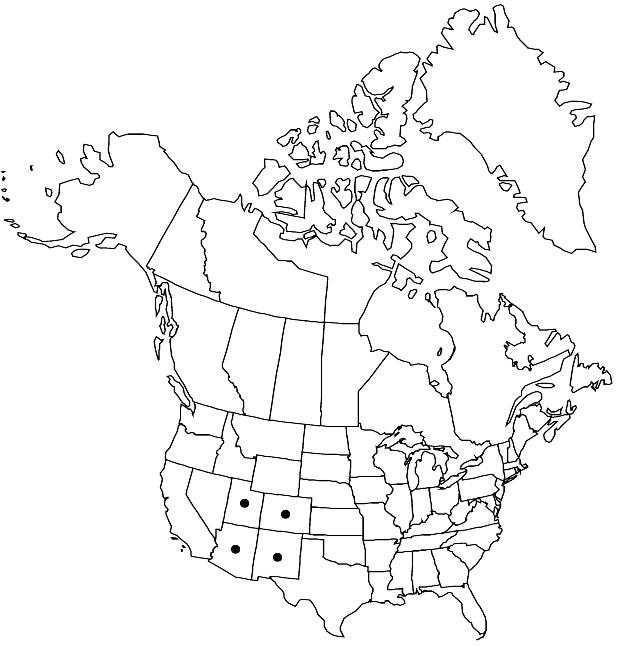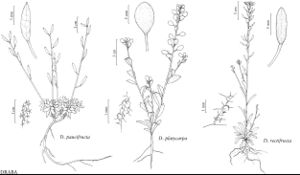Difference between revisions of "Draba rectifructa"
Revis. Drabas W. N. Amer., 110. 1941.
FNA>Volume Importer |
FNA>Volume Importer |
(No difference)
| |
Revision as of 20:22, 24 September 2019
Annuals; not scapose. Stems (usually simple, rarely more, from base), unbranched or branched distally, (0.5–)0.7–3(–3.7) dm, pubescent, proximally trichomes simple and stalked, 2-rayed, 0.4–1.3 mm, with 3- or 4-rayed ones, 0.05–0.2 mm, distally trichomes stalked and 2–4-rayed. Basal leaves rosulate; petiole (obscure), margin ciliate, (trichomes simple, to 1.5 mm); blade oblanceolate to obovate, 1–2(–3) cm × 2–7(–10) mm, margins entire or subapically denticulate, surfaces pubescent, abaxially with simple, 0.6–1.3 mm, and stalked, 2–4-rayed trichomes, 0.1–0.8 mm, adaxially with simple and stalked, 2-rayed ones, 0.4–1.2 mm. Cauline leaves 3–10(–17); sessile; blade lanceolate to ovate or oblong, margins entire, surfaces pubescent as basal. Racemes (15–)20–51(–62)-flowered, ebracteate, elongated in fruit; rachis not flexuous, pubescent as stem. Fruiting pedicels horizontal to divaricate-ascending, straight or curved upward, (2–)3–8(–10) mm, pubescent, trichomes simple and stalked, 2–4-rayed. Flowers: (late-season ones petaliferous); sepals oblong, 1.3–2 mm, pubescent, (trichomes simple); petals yellow (sometimes fading white), oblanceolate, 1.5–3 × 0.5–1 mm; anthers ovate, 0.2–0.3 mm. Fruits lanceolate, plane, flattened, 6–9(11) × 1.3–2.3 mm; valves pubescent, trichomes simple, antrorse, 0.1–0.2 mm; ovules 32–60 per ovary; style 0.01–0.1 mm. Seeds ovoid, 0.5–0.7 × 0.4–0.5 mm. 2n = 24.
Phenology: Flowering Apr–Aug.
Habitat: Open forests, meadows, gravelly knolls, disturbed sites
Elevation: 1800-3200 m
Distribution

Ariz., Colo., N.Mex., Utah.
Discussion
Although O. E. Schulz (1927), C. L. Hitchcock (1941), and R. C. Rollins (1993) indicated that Draba montana was published in 1879; the name was first and validly published in 1878, with a reference to Rothrock’s description of a misapplied Linnaean name (D. nemorosa), which cited specimens that served as Watson’s type collection. Populations of D. rectifructa from northern Utah often grow with D. albertina and there is some evidence of hybridization. The only published chromosome count for D. rectifructa (M. D. Windham 2000) is identical to that of D. albertina and was derived from one of these mixed populations.
Selected References
None.
